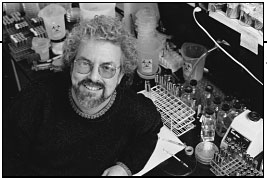Piecing together a microbiology puzzle to defeat cholera
Ronald Taylor, Ph.D., a professor of microbiology at DMS, has been puzzling over the action of one species of bacterium for 15 years now. It is a tiny object of study, but, for him, it contains a universe of possibilities in its organelles, membranes, and chromosomes. He is by now on intimate terms with the deadly Vibrio cholerae, the bacterium that causes cholera.
A recent discovery by Taylor's lab, detailed in a paper he coauthored with graduate student Christian LaPointe, has exciting implications for defeating V. cholerae. But despite the drama of this development, it is only one step in Taylor's long journey. He started working with V. cholerae while he was a postdoctoral fellow at Harvard. That was when he discovered the means by which the bacterium infects its victims, a structure called a type IV pilus. He has studied the organism ever since, leaving a trail of 68 papers and helping to elucidate the biochemistry and structure of V. cholerae. His most recent work, however, hinges on that first discovery.

|
|
Ron Taylor has spent his career studying the deadly V. cholerae bacterium. |
Pili: A pilus is a hair-like polymer of a protein called pilin that projects from the membrane of many bacteria, allowing them to colonize a host. A similar, but as yet unidentified, mechanism plays a role in the delivery of toxin from the bacterium to the host through what is called a type II secretion system. The pili and the pilus-like secretion system are essential to the bacterium's expression of its virulence. When the genes that code for pili are deleted, V. cholerae is simply flushed through an animal's system, causing no harm.
Puzzle: Taylor started by looking at how pilin is produced and how it then passes into the pili. He compares this sort of groundwork to a puzzle: "All the time I think of how does this organism work? . . . How does it know it is in . . . someone's intestine? . . . And what are all the things it does to turn on these systems and secrete these toxins?"
Over the years, Taylor and other researchers have answered one question after another, filling in pieces of the puzzle but always turning up new questions. They learned that pilin is first produced within the cell in a precursor form. It is then shorn of a leader peptide, diffused out of the cell, and joined to pili by the action of a family of molecules called type IV prepilin peptidase (TFPP)—large proteins that straddle the cellular membrane. Taylor's lab discovered two types of TFPP in V. cholerae, one (called TcpJ) that plays a role in the formation of pili and one (called VcpD) that regulates the excretion of toxin.
Inhibiting the action of TFPP would prevent both the formation of pili and the excretion of toxin, rendering V. cholerae harmless. Taylor set out to discover the active site of TcpJ and VcpD. By analyzing the many homologues of these compounds, he was able to determine which amino acids were essential to the function of TFPP and to identify two aspartate residues present throughout this family of molecules. Through mutagenesis of every potential amino acid, he confirmed that only these two were absolutely required for protease activity in TFPP.
Taylor then went looking for a compound that would inhibit this action. After screening databases of known protease inhibitors, he eventually came up with one and verified its effectiveness in the lab. At this point, he says, "we understand the chemistry, we know what can inhibit the enzyme—we've demonstrated it both genetically and biochemically. Now let's use that information." The next step, he says, is designing a human drug based on the compound.
He explains why this method of inhibiting TFPP holds such promise: "A good antimicrobial target is specific in that it's a part of how the microbe functions but not part of how we function." Indeed, this chemical pathway is not found in higher organisms. Furthermore, Taylor's approach is similar to the protease inhibitors that have proven effective in treating HIV infection. Perhaps most exciting is the fact that similar pathways have been identified in over 50 other bacteria, including the microbes that cause meningitis and pathogens found in patients with cystic fibrosis.
"[This] takes basic research and brings it to practicality. . . . I think that's the satisfying part from our point of view, certainly mine," says Taylor. But having found this answer won't bring an end to the questions Taylor asks himself. There is much more to be discovered about V. cholerae. For instance, there's that mysterious secretion system to decipher. His lab is also looking at developing a vaccine against V. cholerae using the pilus as an antigen. And he's also fascinated with the organism's genetics.
Machine: "It's a living machine that has a limited number of genetic components that you can address," he explains. "Looking [at] the 4,000 genes that make the organism do everything it does . . ." Then he pauses, groping for the right word to express how captivated he continues to be by V. cholerae, and one senses that maybe, just maybe, he will someday finish piecing together that puzzle.
Jonathan Weisberg
If you would like to offer any feedback about this article, we would welcome getting your comments at DartMed@Dartmouth.edu.
